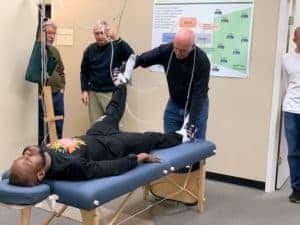
The purpose of the study is to determine if the Global Mechanical Assessment (GMA) could be a low-tech, clinically observable surrogate for the neurologic changes associated with the correction of a subluxation through application of a chiropractic adjustment.
To measure changes, individuals will be outfitted with ten wireless electromyography sensors that will assess abdominal core responsiveness to the GMA testing. The abdominal musculature serves as an initial brace, stabilizing the body prior to movement onset. Abdominal core responsiveness has been used in previous studies to represent feedforward activation as part of an individual’s anticipatory preparation for movement onset.
Individuals will also be outfitted with four wireless inertial measurement units to assess the individual’s response to long-lever and short-lever mirror image isometric testing of all limbs. To serve as an accepted standard of comparison, proprioception will be evaluated using the NeuroCom Dynamic Equitest Sensory Organization Test (SOT). The SOT is designed to discriminate between the proprioceptive, vestibular and visual components of balance.
The project is still in development with the anticipation that the study will be approved by the Life University Institutional Review Board in February of 2020. Upon approval, recruitment and data collection will begin with Life University’s Dr. John Downes as the lead clinician.

Social Media